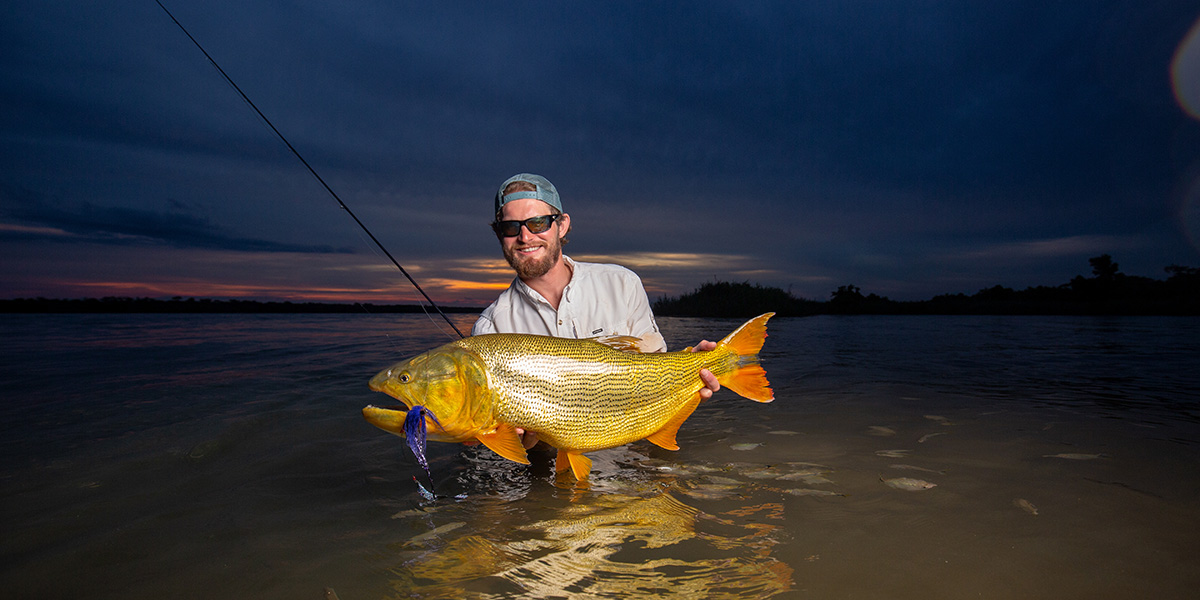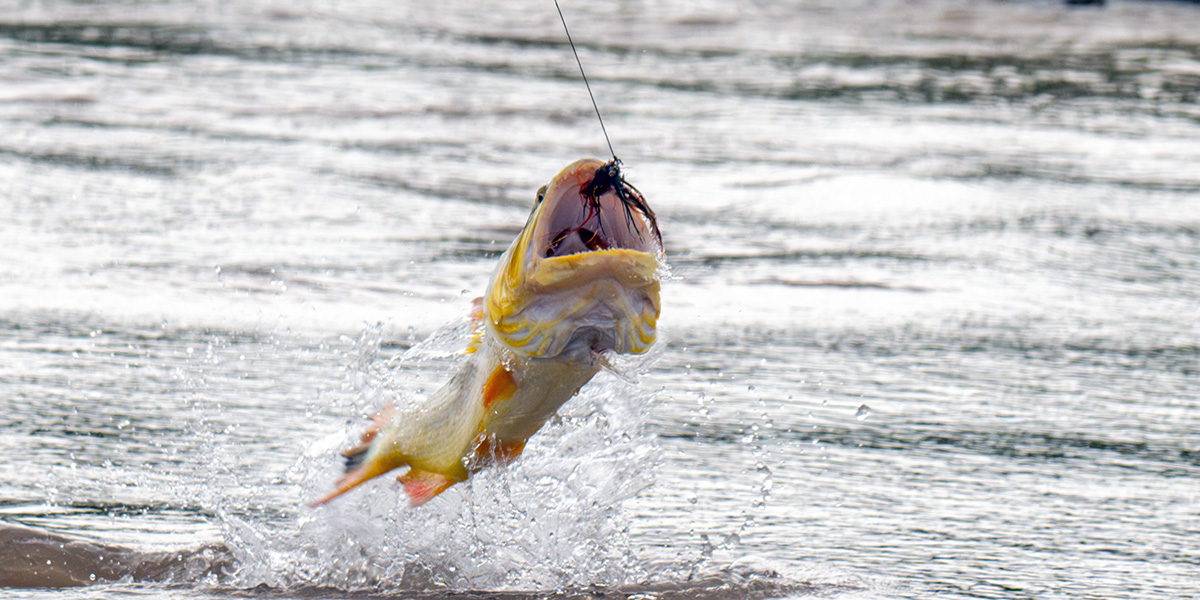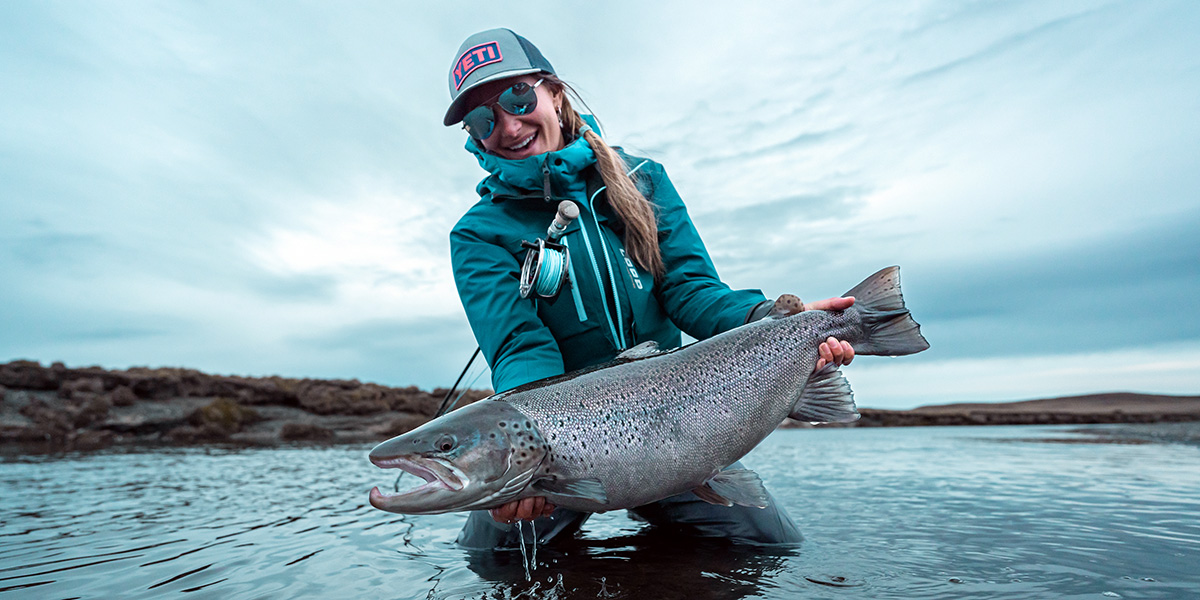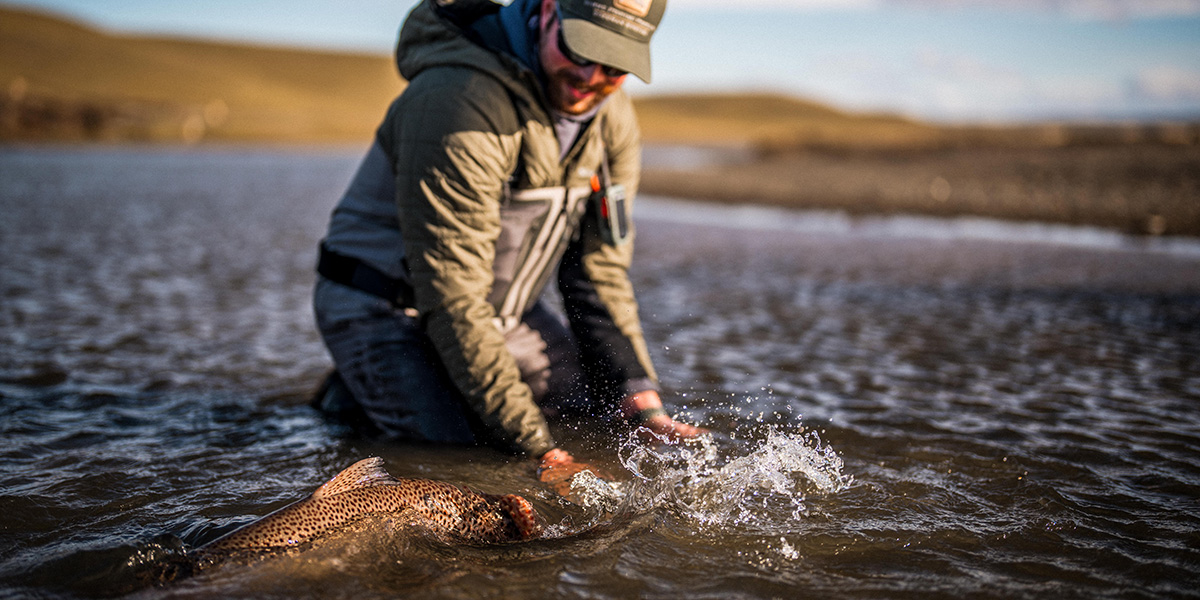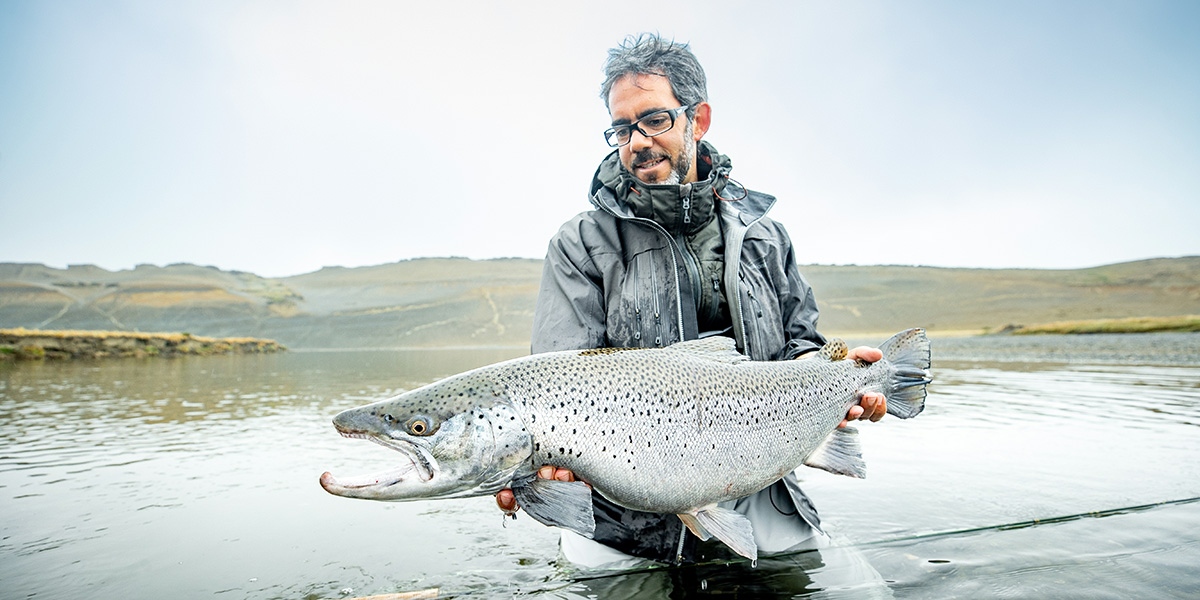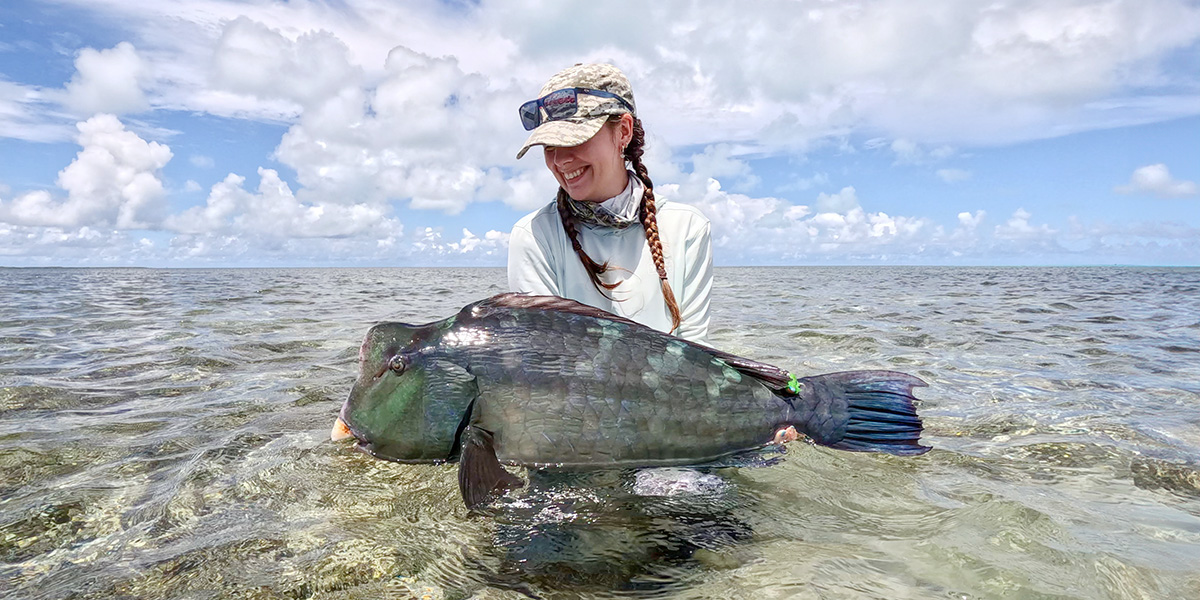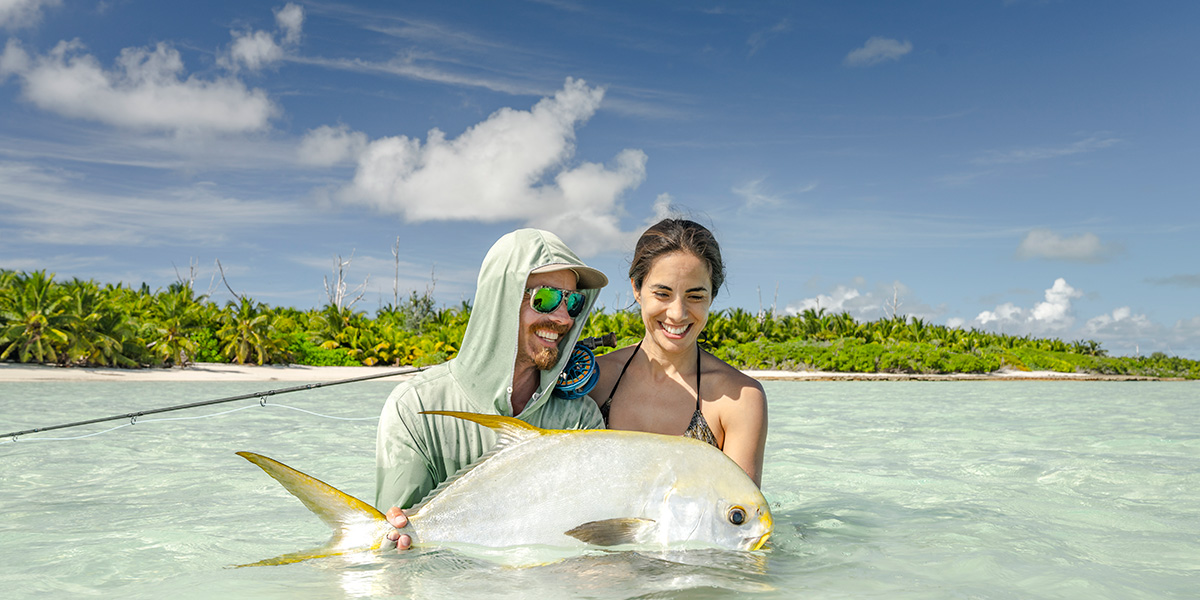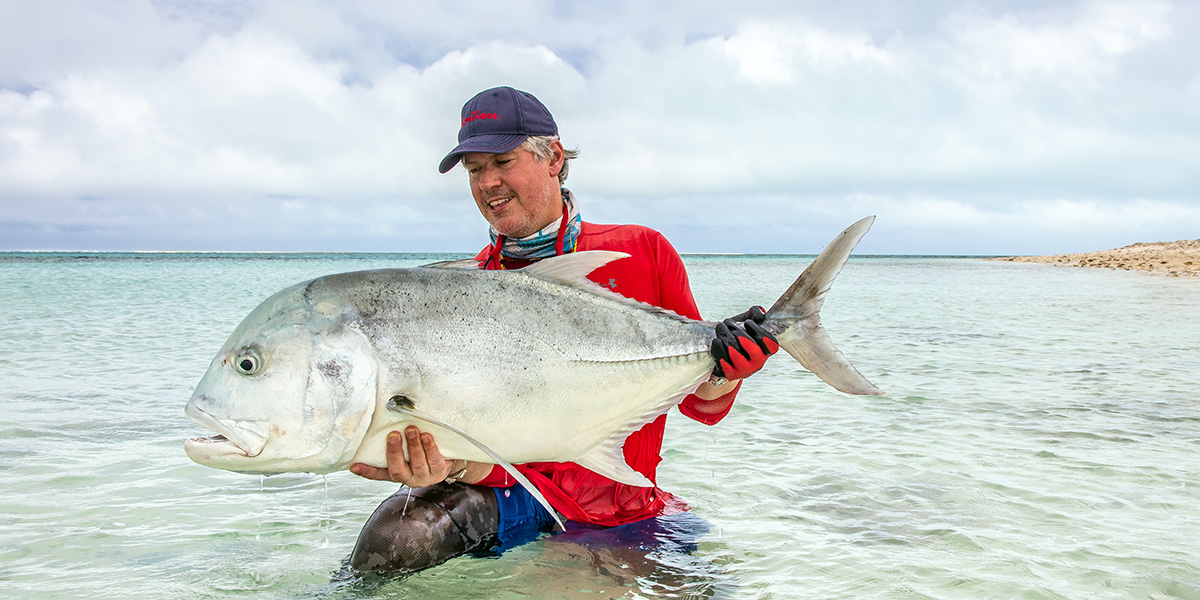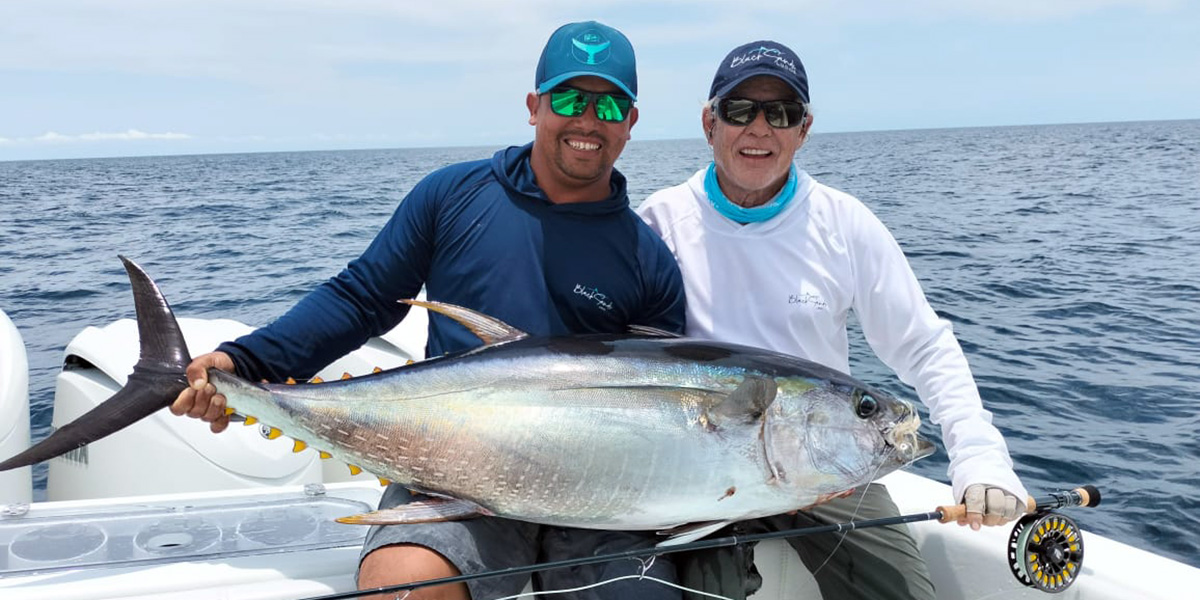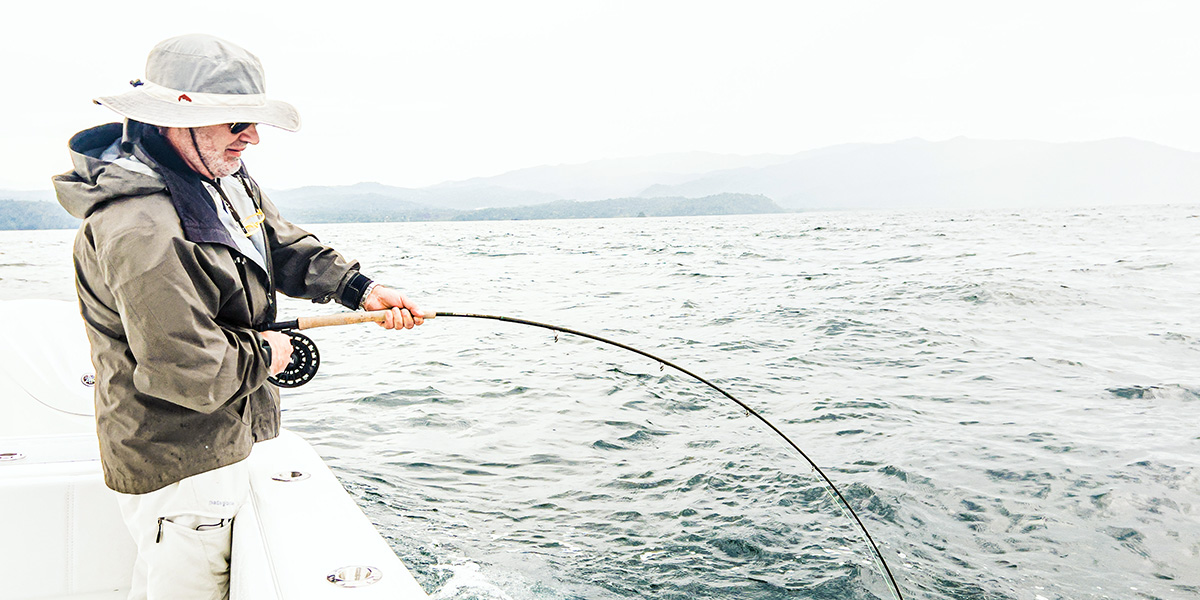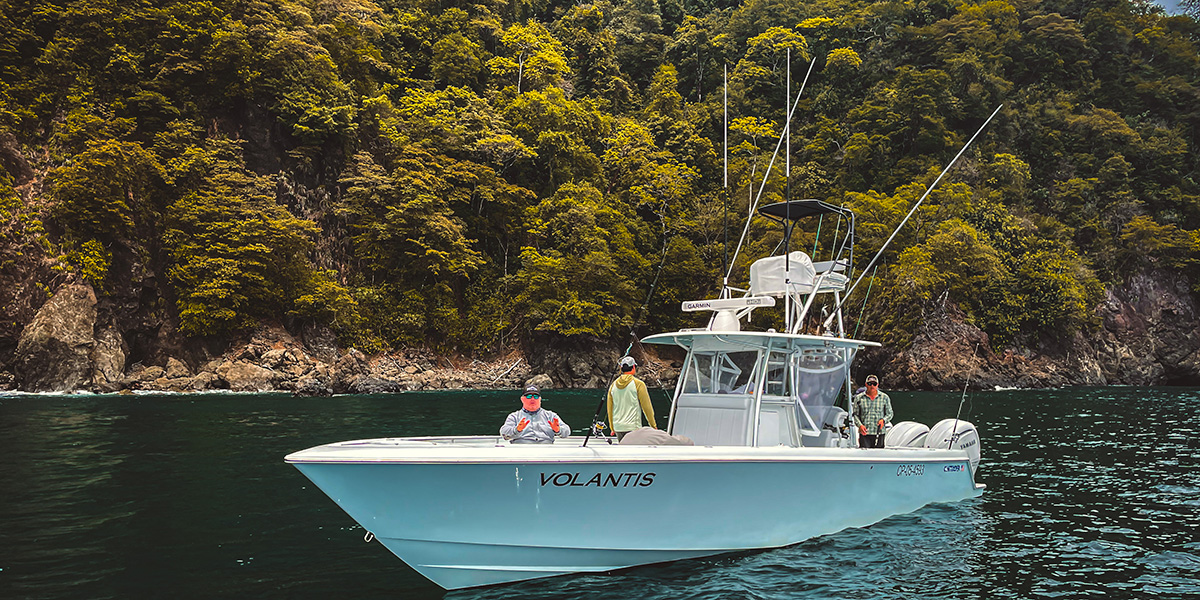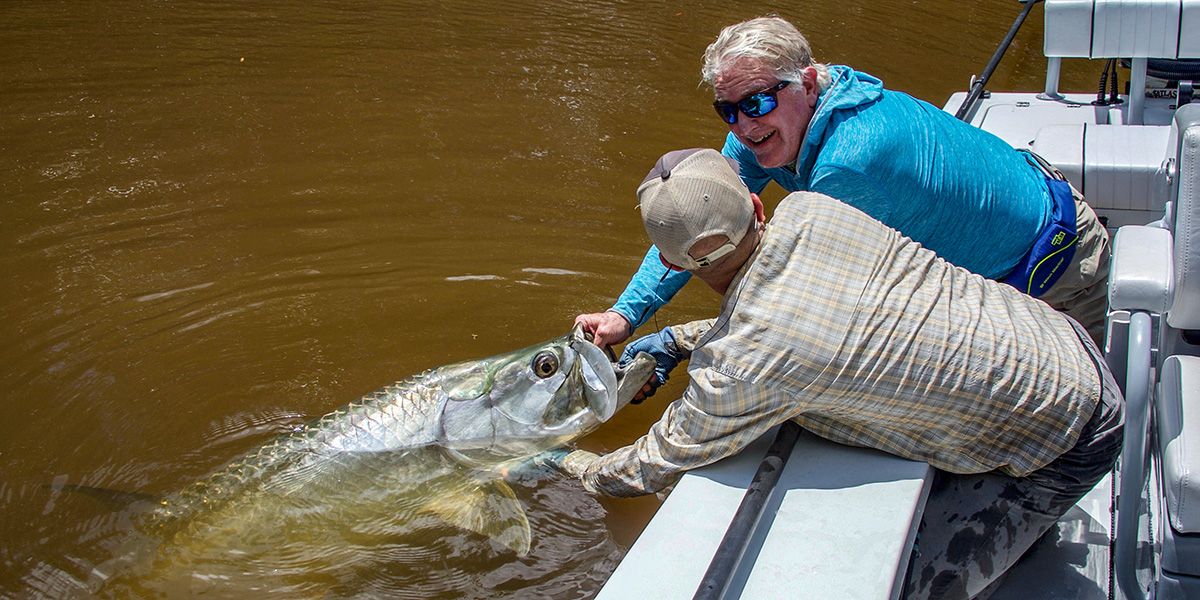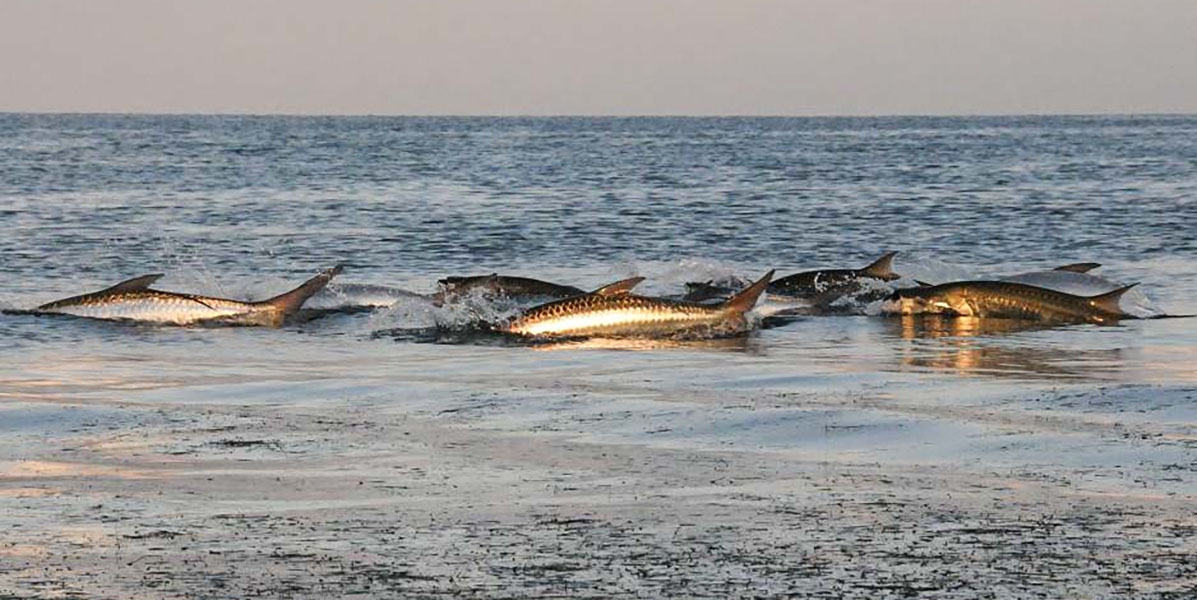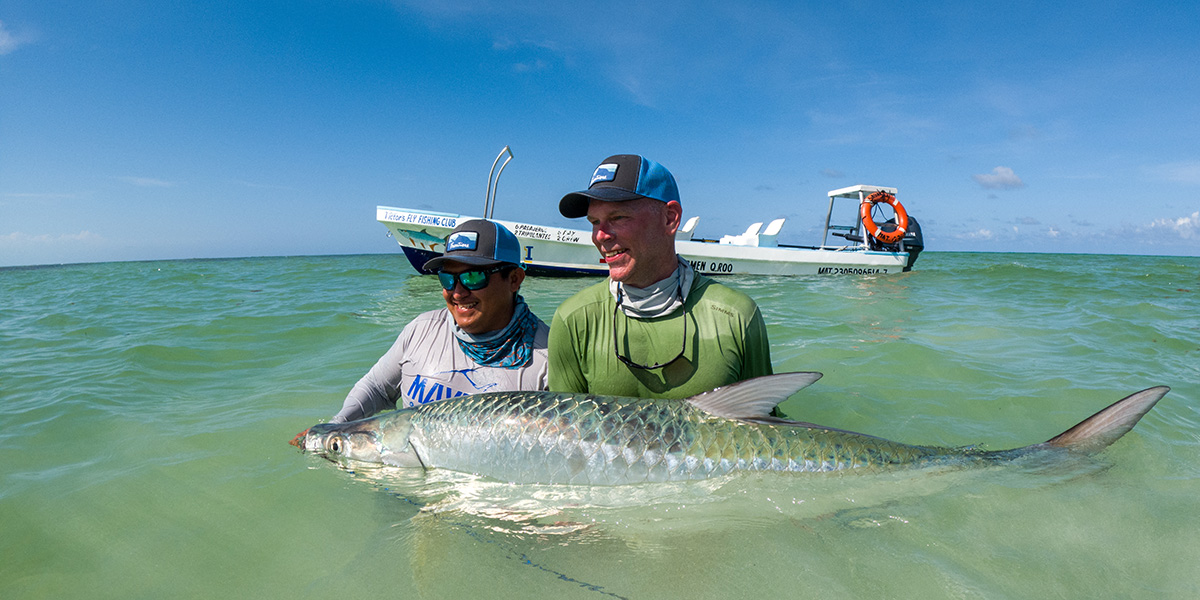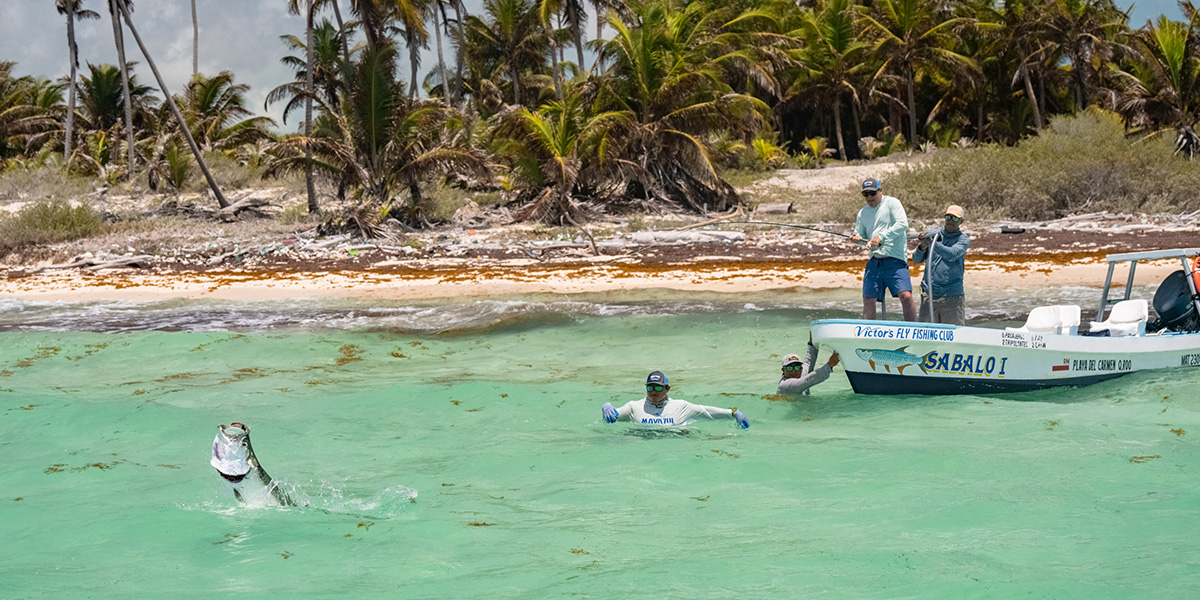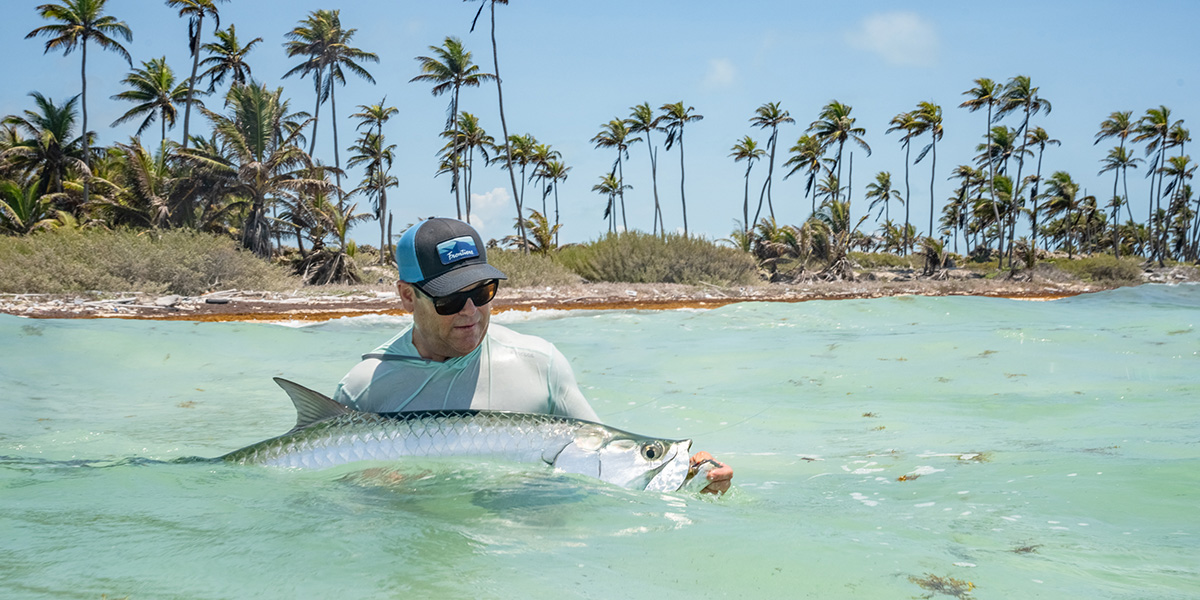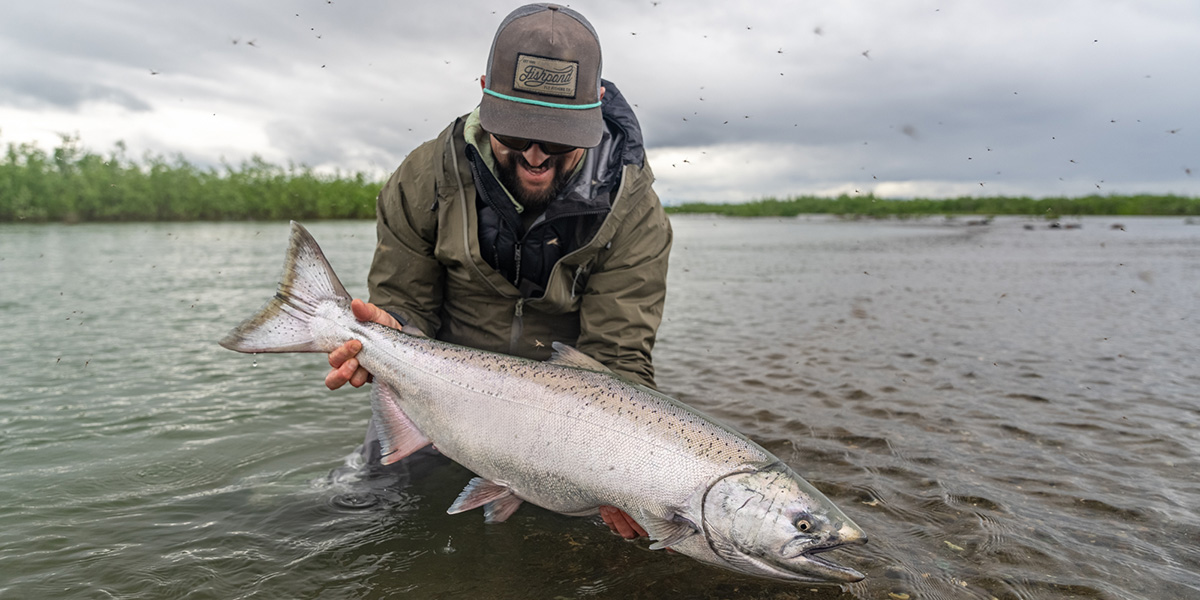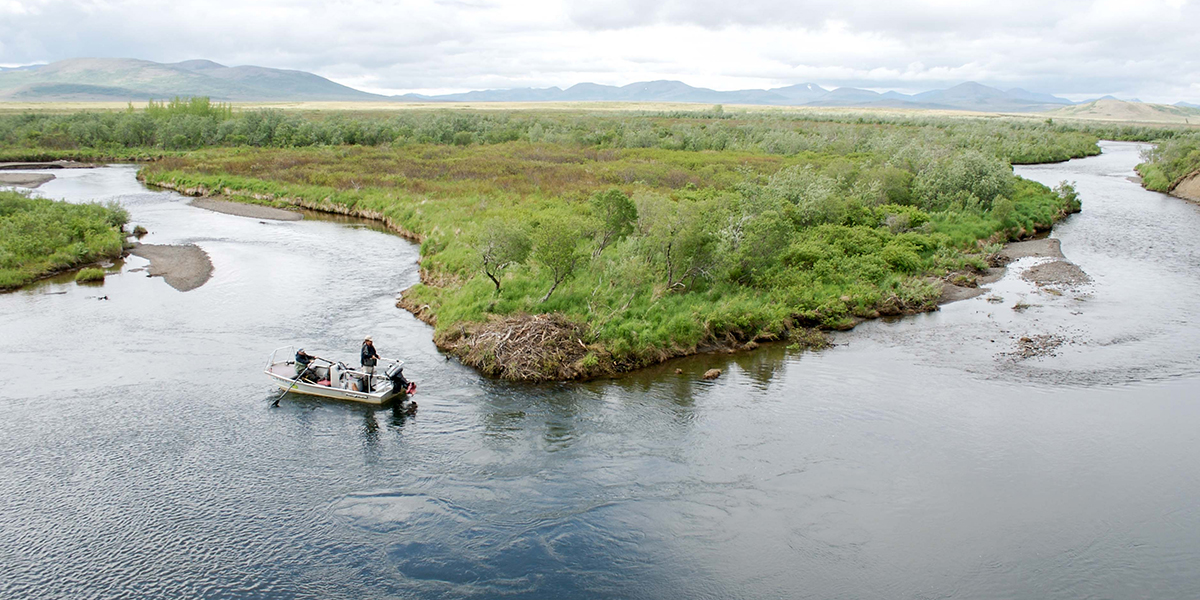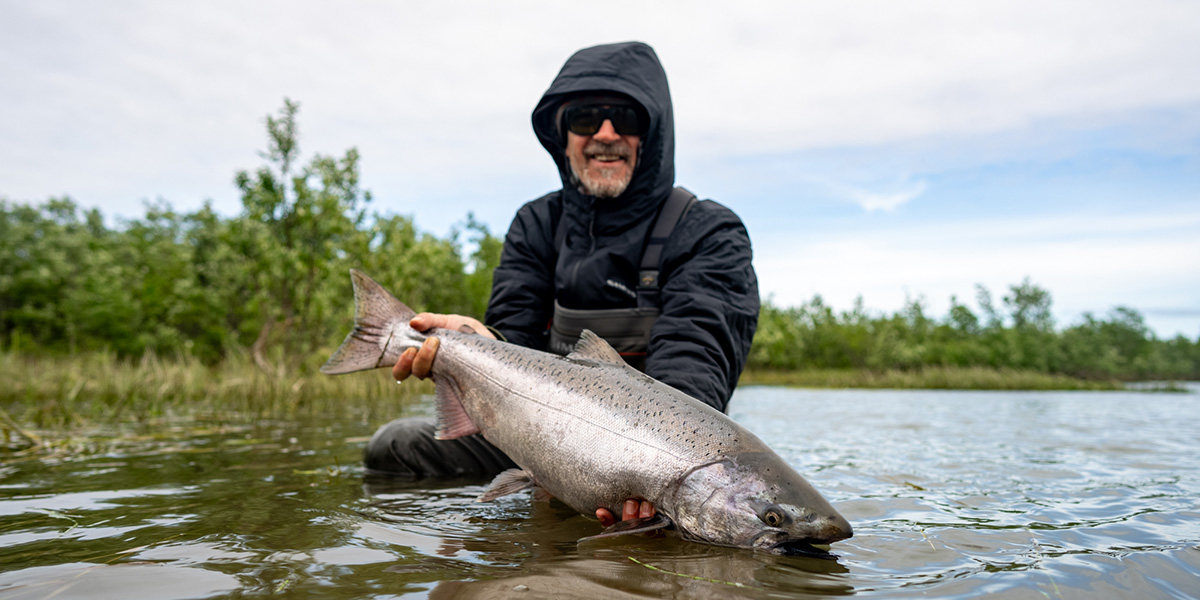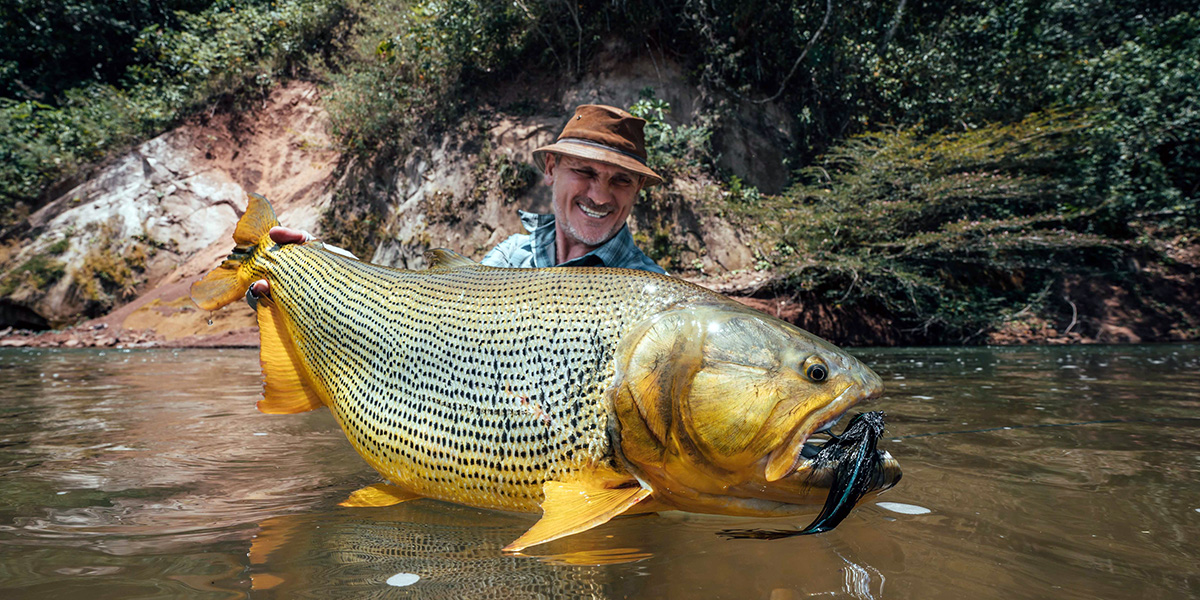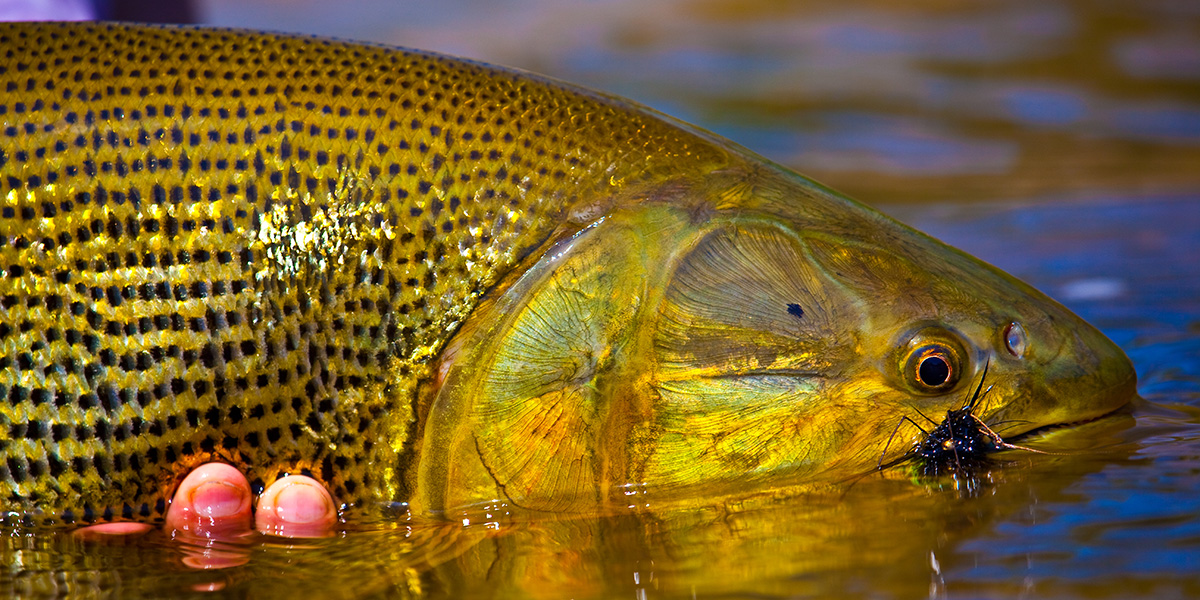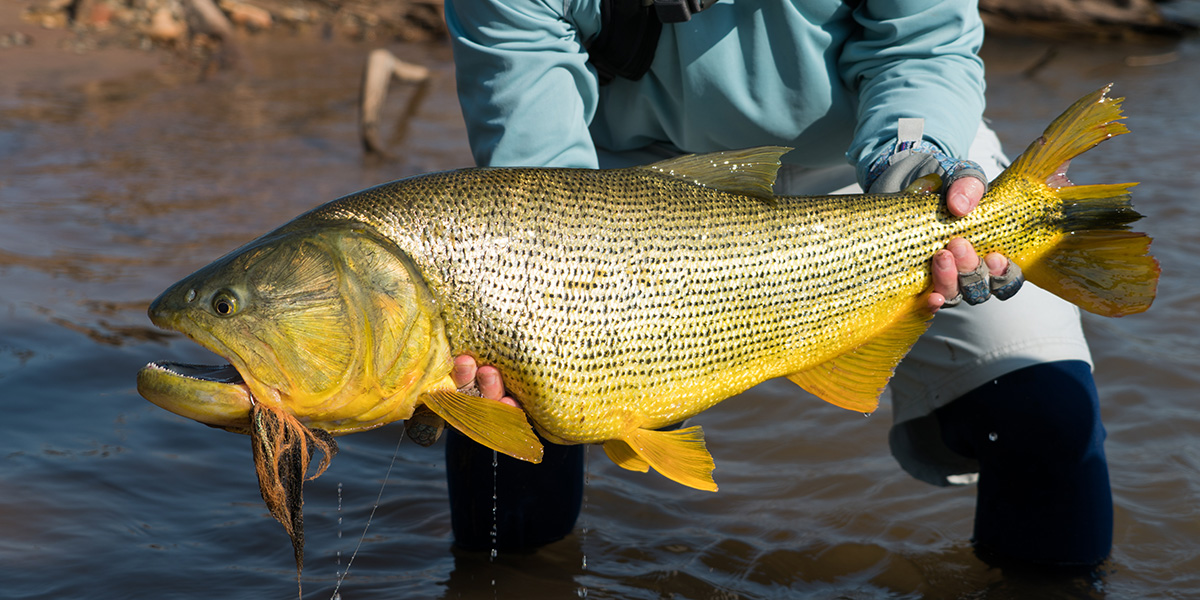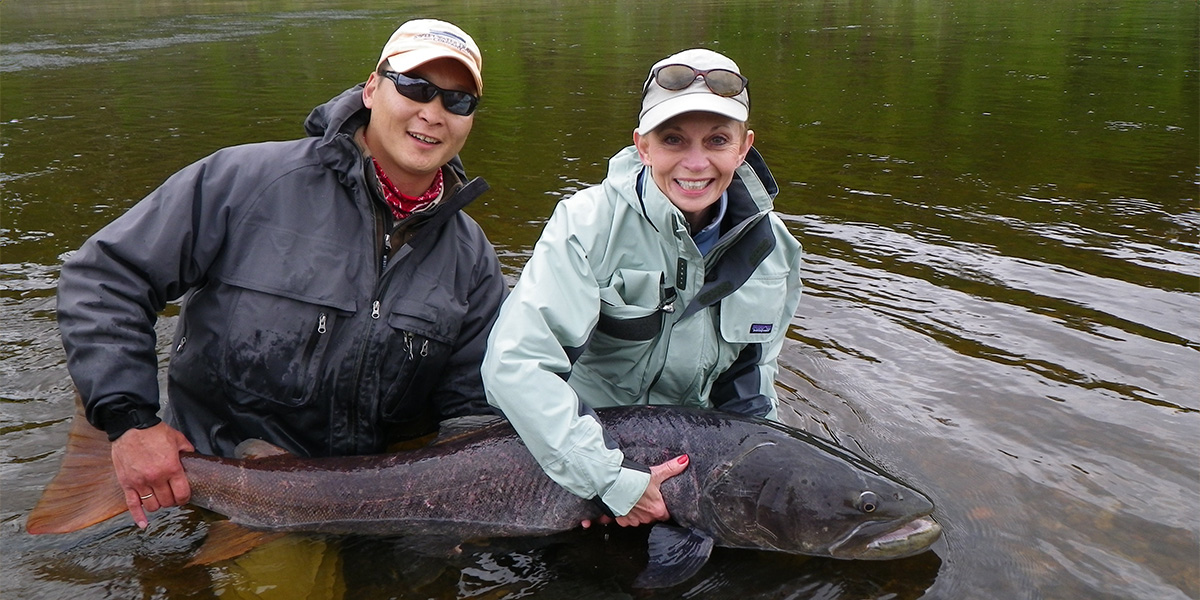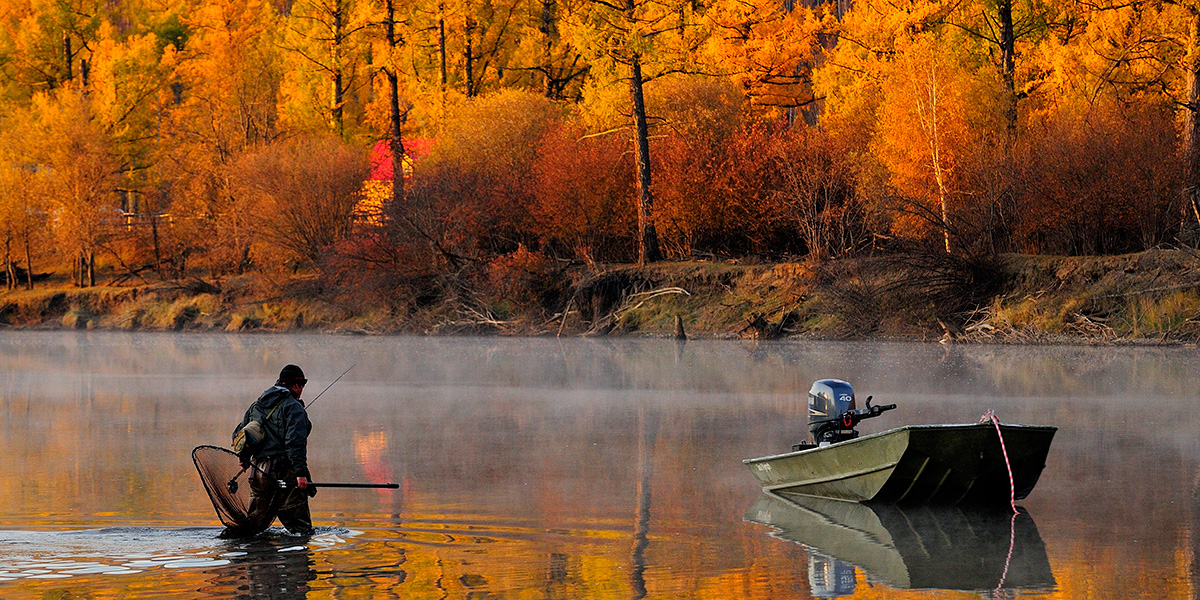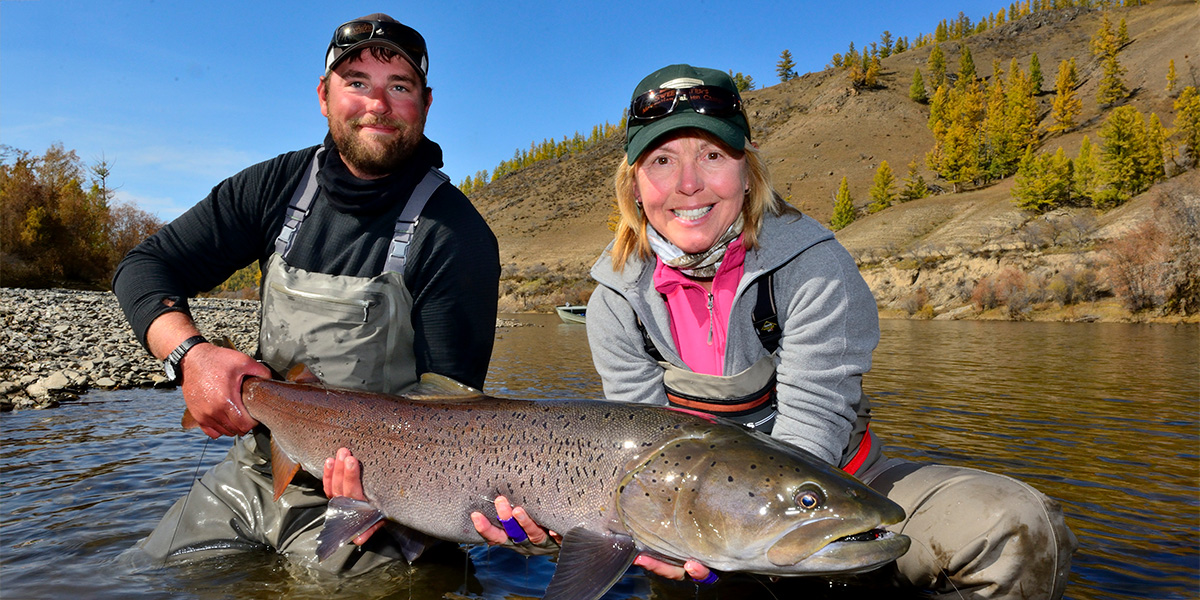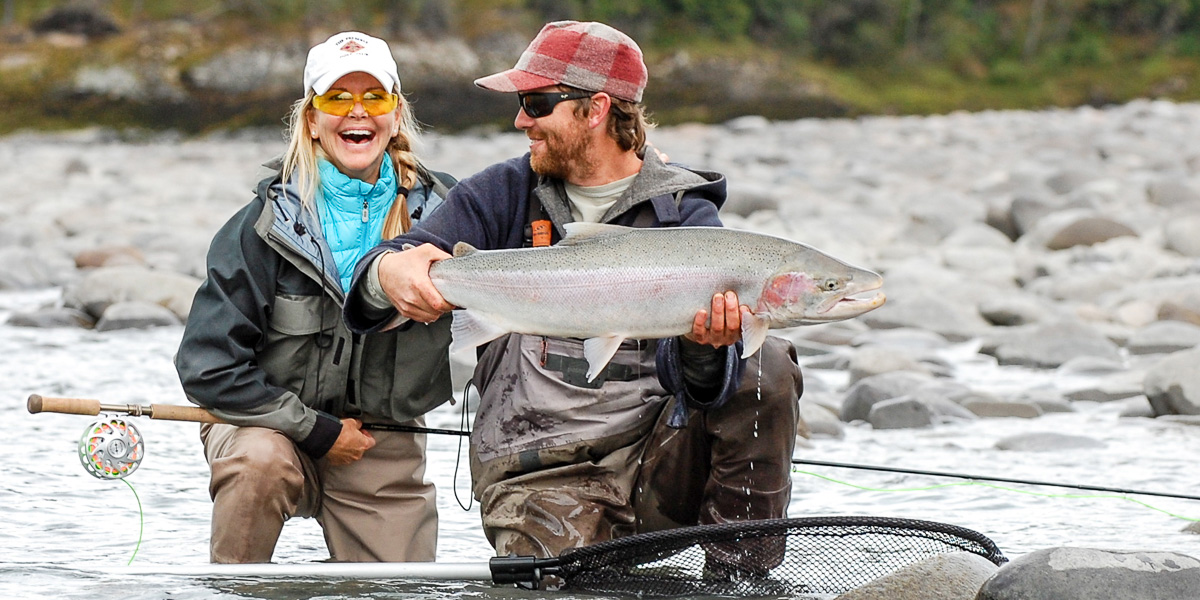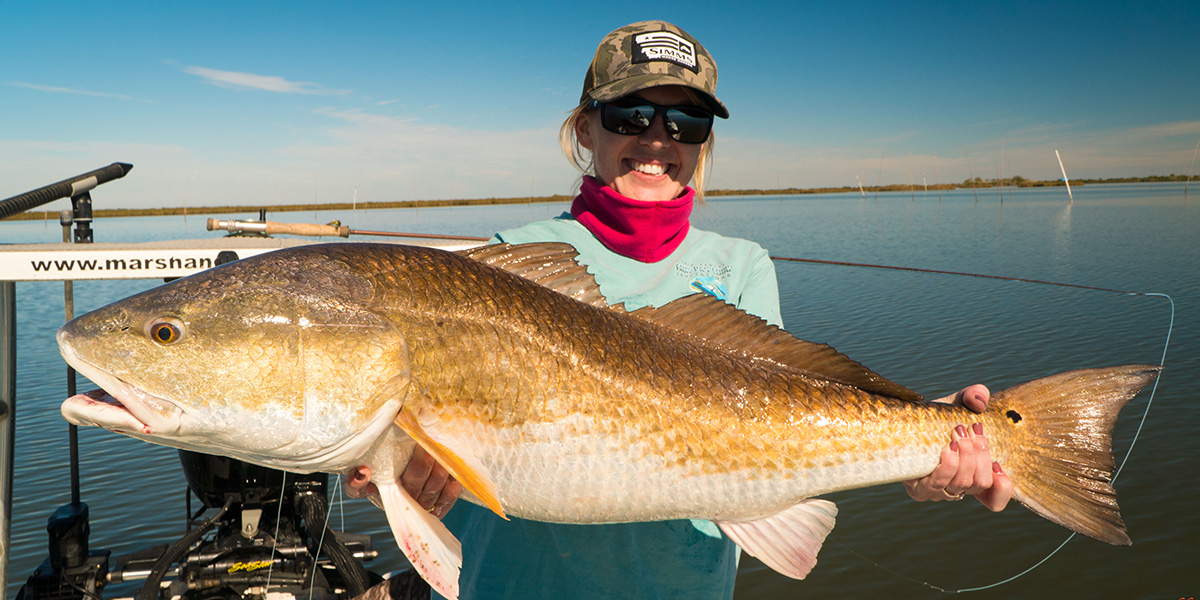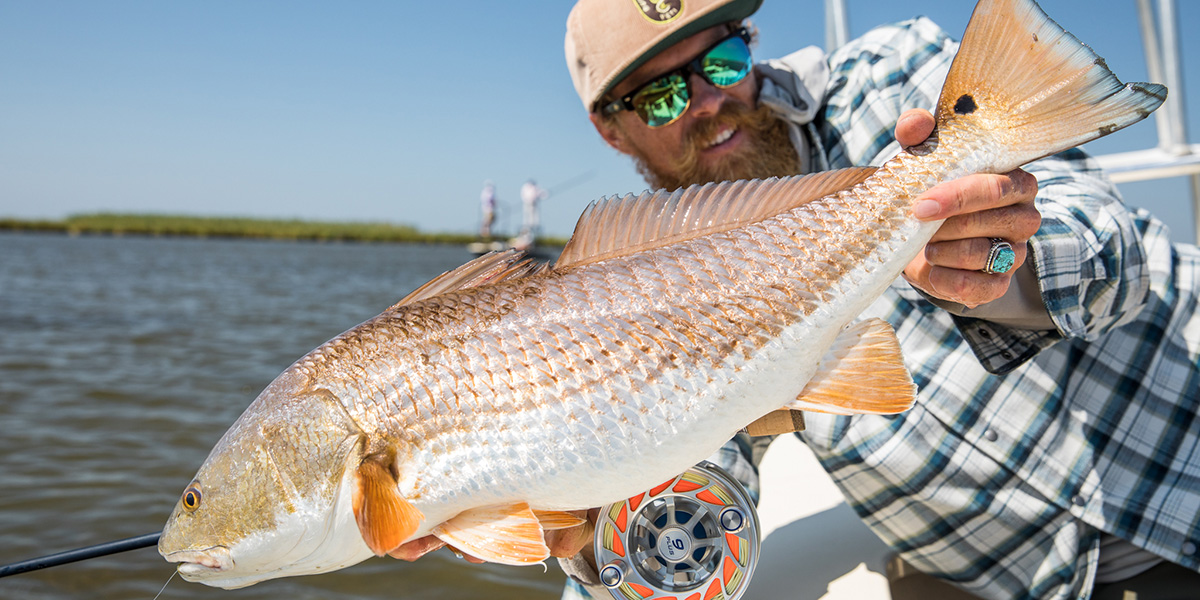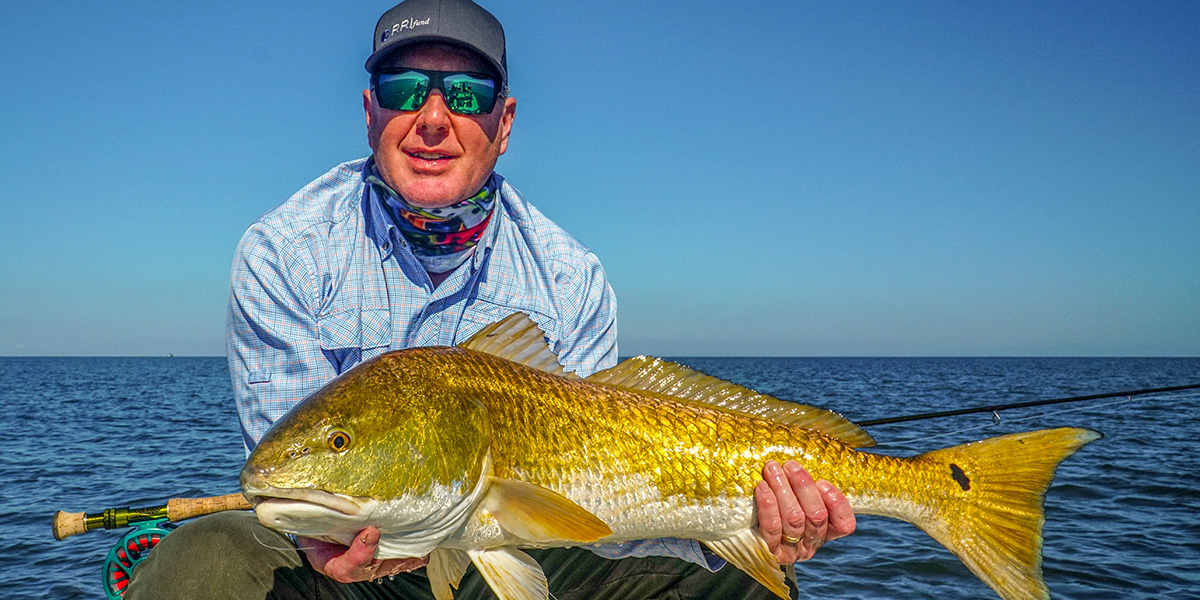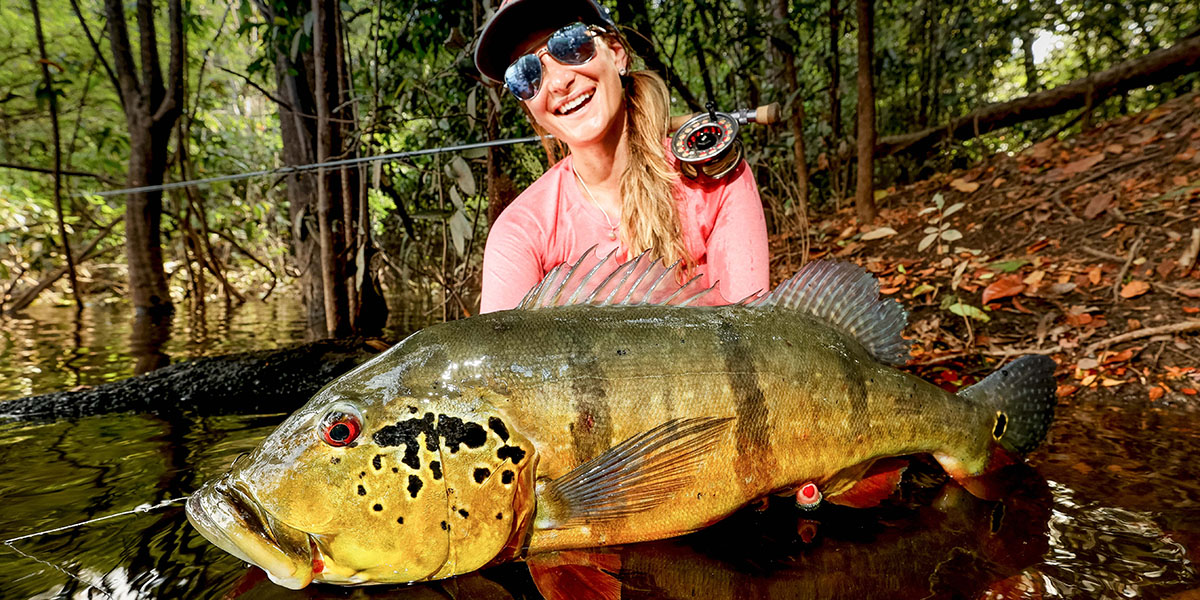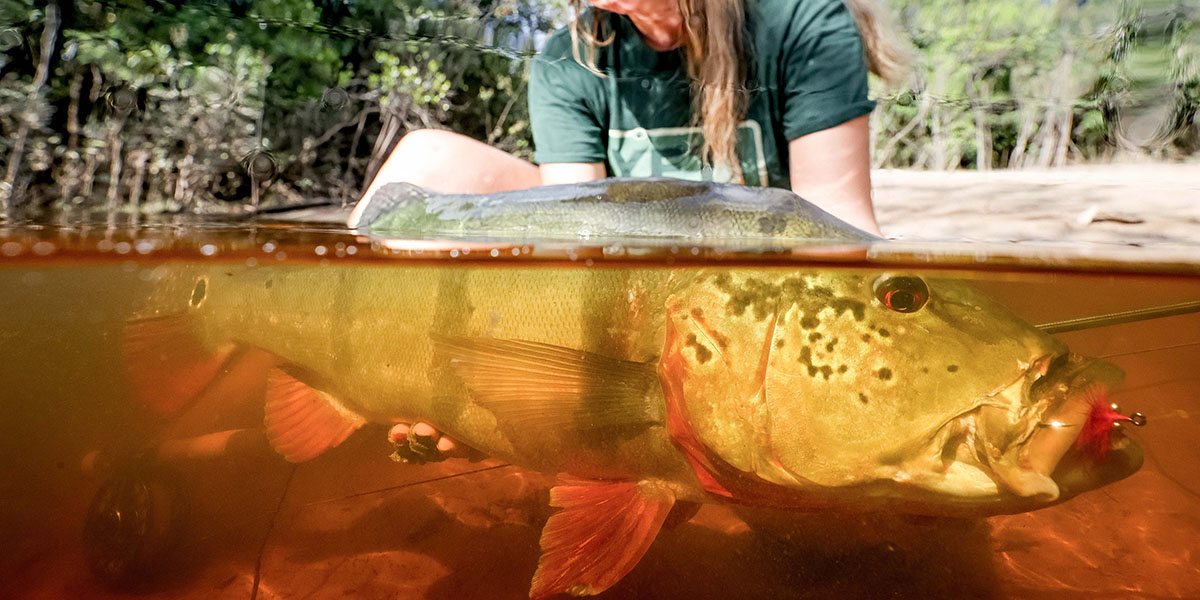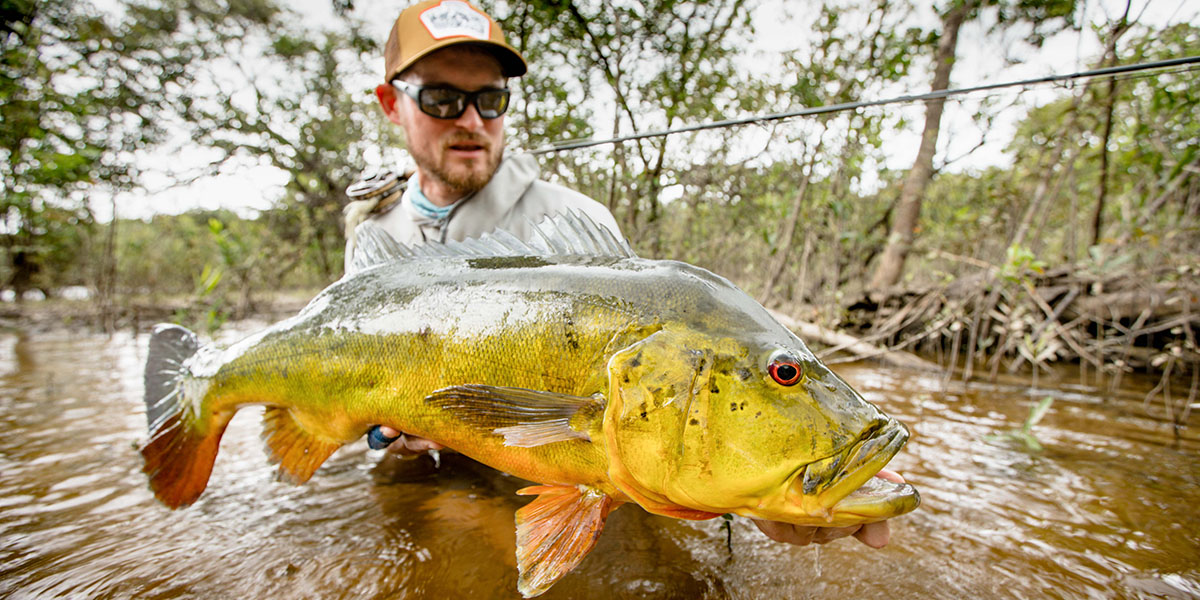International Fly Fishing Destinations with Trophy-Sized Fish
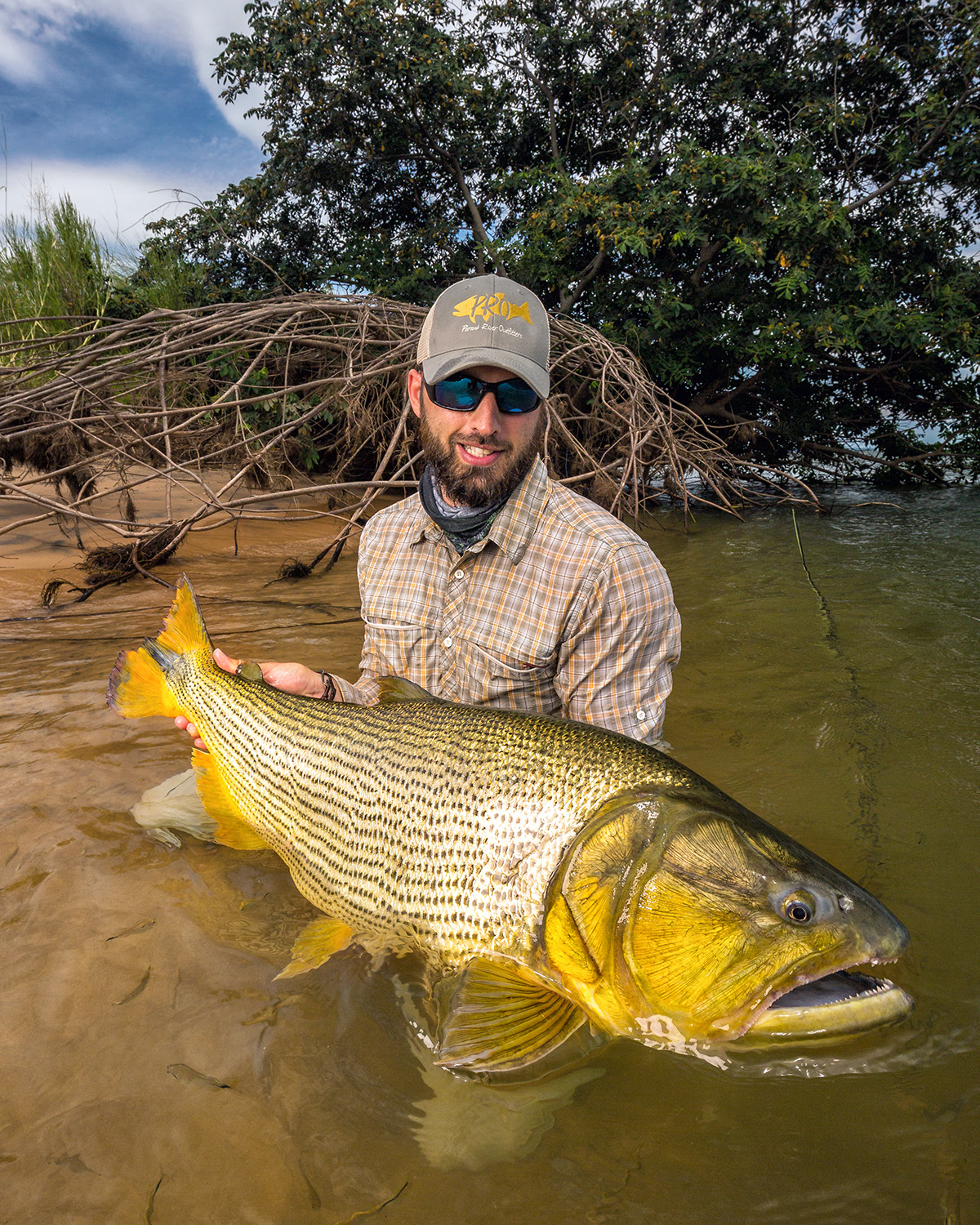
A seasoned friend once described to me, The Angler’s Journey, based on his many years of fly fishing experience: first, you want to catch any fish; next, you want to catch a lot of fish; then, you want to catch big fish; and finally, for some, they want to catch fish a certain way. No doubt you and I could have a rich and lively discussion over a couple of beverages (or on a social media thread) as to the truth and variances from many points of view on this journey. For now, please allow me this one point: we as fly anglers have a variety of expectations that drive us to pursue, at times with near-obsessive passion, the next great fishing experience, with the definition of “great” varying from one to the other. And for some anglers, a great trip means chasing really big fish, the kind that requires both hands (or even multiple people) to hold up for that classic grip-n-grin hero photo. These trips for trophy fish are designed for the angler who values quality over quantity. From giant trevally in the Seychelles to king salmon in Alaska and golden dorado in Bolivia, we have curated a travel guide with destinations known for producing fish-of-a-lifetime opportunities throughout the calendar year.
Are these destinations or style of travel not for you? Check out some of our other articles to learn how you can fish all year:
- Easy to Reach Fly Fishing Destinations
- Best Places to Catch Trout Each Month for Traveling Anglers
- Travel Destinations that are Great for New Fly Fishers
- Fishing for Numbers: Destinations with Strong Catch Rates by Month
- Group Friendly Fishing: Monthly Guide to All-Inclusive Trips
- Remote Fishing Trips by Month: Off-the-Grid Angling Spots
- Monthly Guide to Sight Fishing Around the World
The Gold Standard – Monster Dorado in Peak Summer Mode
Argentina – January
January marks the peak of trophy golden dorado fishing in Argentina. With summer heat in full swing, water levels in prime fisheries like the Paraná River, Iberá Marshlands, and Uruguay River stabilize, concentrating baitfish and drawing in aggressive dorado. This month offers some of the best chances to catch dorado in the 15-30+ pound range.
Why January is Prime for Big Dorado:
- Warm Water=Aggressive Fish: High temperatures make dorado highly active, chasing large streamers and surface flies with explosive strikes.
- Abundant Prey: Concentrated sabalo (baitfish) attract trophy dorado, giving anglers consistent shots at fish over 15-20 pounds.
- Stable Conditions: The Paraná, Uruguay, and Iberá systems have steady water levels, creating productive feeding lanes and ideal sight-fishing conditions.
Top Locations for Trophy Dorado:
- Paraná River: A world-renowned fishery with dorado exceeding 30 pounds caught annually. In January, aggressive fish ambush bait along sandbars and submerged structures.
- Iberá Marshlands: This pristine wetland offers sight-fishing for dorado in clear, shallow water, with January bringing shots at double-digit fish in deep pockets and feeding channels.
Dorado Sizes in January:
- Average: 8-15 pounds
- Trophy: 20-30+ pounds
- Best Locations: Paraná and Uruguay Rivers for giants over 30 pounds.
Contact our Expert: Hank Ingram
Call: 1-800-245-1950
Trophy Sea-Run Brown Trout at the End of the World
Tierra del Fuego – February
February marks peak season for trophy sea-run brown trout on Argentina’s renowned Río Grande and Río Gallegos. With stable water levels and aggressive fish, anglers frequently hook trout over 15 pounds, with 20- to 25-pound specimens caught regularly.
Río Grande – Big Fish, Consistent Action
The Río Grande is the world’s premier river for massive sea-run brown trout. February sees fresh fish pushing upstream and earlier arrivals settling into prime lies. Average fish size ranges from 10-15 pounds, with frequent opportunities for trophies over 20 pounds.
- Villa María Lodge: Located on the lower Río Grande, offering first access to fresh, powerful fish. Ideal for two-handed Spey casting and covering wide pools.
- Kau Tapen Lodge: Positioned upstream, with productive middle river beats perfect for single-hand or switch-rod tactics.
Río Gallegos – Untouched Trophy Fishing
Less crowded than the Río Grande, the Río Gallegos offers technical fishing with stealthy approaches and lighter rods.
- Bella Sofia Lodge: Provides access to unpressured stretches and sight-fishing opportunities in cut banks and gravel bars.
- Río Chico: A tributary offering resident brown trout fishing, ideal for delicate dry-fly presentations.
Why February Is Best:
- Large, aggressive fish are well-distributed, and stable conditions keep them feeding actively. With private access minimizing pressure, anglers can expect consistent hookups and trophy fish encounters throughout their trip.
Contact our Expert: Hank Ingram
Call: 1-800-245-1950
The Flats Turn Violent with GTs on Patrol
Seychelles – March
March is prime time to target trophy giant trevally (GTs) on the fly in the Seychelles. As the wet season shifts to drier conditions, tides stabilize, bringing GTs into shallow flats, channels, and surf zones. Anglers can expect consistent opportunities to hook 40- to 50-pound fish, making March essential for serious saltwater fly anglers.
Why March Is Best for GTs:
- Peak GT Presence on the Flats: Big GTs move into shallow water to ambush baitfish, offering thrilling sight-fishing opportunities.
- Strong Tidal Cycles Drive Feeding: Defined tides concentrate prey, making GTs aggressive and more likely to charge down flies.
- Stable Weather & Clear Water: Calmer conditions improve visibility, allowing anglers to spot and cast to trophy fish before they spook.
Top Spots for Trophy GTs in March:
- Cosmoledo Atoll: The GT capital, known for trophy-sized fish patrolling flats, surf zones, and deep channels.
- Farquhar Atoll: Home to big, aggressive GTs cruising sandbars and coral edges, with fish frequently breaking the 100 cm mark.
- Astove Atoll: A natural funnel drawing large GTs into shallow water, consistently producing some of the biggest catches of the season.
What to Expect:
- Expect GTs averaging 70-90 cm (27-35 inches), with trophy fish over 100 cm (40+ inches), often exceeding 40-50 pounds. Skilled anglers can realistically land multiple GTs per day.
Contact our Expert: Hank Ingram
Call: 1-800-245-1950
Bait Balls Against Black Sand Beaches
Colombia – April
April offers an extraordinary window for bluewater anglers to visit Black Sands Lodge. Tucked in Colombia’s northern Pacific coast, Black Sands Lodge is surrounded by rainforest and endless ocean, offering access to some of the least-pressured fishing waters anywhere in the world. During April, the ocean springs to life with the start of the sardine run. Yellowfin tuna, mahi-mahi, sailfish, roosterfish, and cubera snapper will all come closer to shore, often within sight of the black sand beaches. For the fly or light tackle angler, these bait balls offer a special opportunity to cast from a stationary boat.
Getting to black sands is simple despite its remote location. You’ll fly into Medellín, overnight in a local hotel, and the next day catch a short domestic flight to Bahia Solanos and an easy boat transfer to the lodge. Once you arrive at Black Sands, you will enjoy newly renovated luxury accommodations, wonderful, internationally-inspired cuisine, and outstanding service by the seasoned staff. The lodge operates two Contenders, ensuring your time on the water is equally enjoyable. Full tackle, including high-end fly tackle, is provided.
Contact our Expert: Joe Koziara
Call: 1-800-245-1950
Massive Tarpon in the Florida Keys
Florida Keys – May
Locals and well-versed tarpon anglers may suggest April or even March to target the largest of tarpon in the Florida Keys, when the big females come onto relatively shallow flats. However, for most fly anglers who want the best combination of quality and quantity (and more consistent weather), May should be the target month to travel to the Keys for tarpon. May is the peak of the tarpon migration, with adult tarpon averaging 80-120 pounds. Trophy tarpon of the 130-150 pound range (and larger) is not uncommon. Keys tarpon are notorious for requiring precise casting and subtle presentations. Which tends to be true, until it’s not. Like in permit fishing and other flats scenarios, there is a mixture of truth, fiction, and exceptions when it comes to chasing the large adult tarpon around the Keys. During the migration, expect your guide to have you throwing a palolo worm fly or a small baitfish pattern.
Large schools of tarpon traverse the clear, shallow flats, offering prime sight-fishing opportunities. The Florida Keys’ unique geography, with its blend of ocean-side flats and secluded backcountry waters, provides diverse environments to target migratory tarpon.
- Ocean-Side Flats – Here, massive schools of migratory tarpon move along the coastline, offering some of the most exciting true sight-fishing opportunities.
- Backcountry Channels and Basins – In deeper waters, big, laid-up tarpon provide thrilling chances at slow-moving giants, requiring patience and a perfect presentation.
- Bridges and Passes – Some of the largest fish of the season stack up in tidal zones, where they ambush baitfish and palolo worms, making for explosive eats.
This variety in settings allows guides to adapt to changing conditions, accommodate anglers’ preferences, and offer unique experiences from day to day or trip to trip. In the minds of many anglers, this diversity, combined with the sheer number of migrating fish, solidifies the Florida Keys as the premier destination for those seeking the thrill of sight-fishing to large, migratory tarpon.
Contact our Expert: Joe Linscott
Call: 1-800-245-1950
Hot Action for Quality Permit and Migratory Tarpon in the Yucatan
Mexico – June
Mexico’s summertime flats fishing is quickly growing its reputation as a quality migratory tarpon option. June has both strong numbers of tarpon, as well as permit, with typically stable and pleasant weather conditions. While there are multiple quality fisheries around the Yucatan, we especially love Ascension Bay for targeting tarpon in June. The bay hosts both resident and migratory tarpon. June is an excellent time to encounter large tarpon on ocean-side flats and near deeper channels adjacent to flats.
Ascension Bay originally became famous for its permit fishing, with June being an excellent month to target these frustrating and amazing fish. Anglers can find permit feeding on both interior and exterior flats around the bay. The ocean-side flats are particularly exciting in June, with excellent chances to run into schools of permit in proximity with migratory tarpon, jacks, ‘cudas, and other species. The chaos in the panga of switching rods and rigs to match the species present can be thrilling and memorable.
Contact our Expert: Ben Hoffman
Call: 1-800-245-1950
Swinging Flies for Chinook in Alaska’s Wild Rivers
Alaska – July
July marks the peak of the king salmon run in Alaska, offering fly anglers exceptional opportunities in gently flowing and easily waded streams and rivers. Both novice and seasoned anglers can experience numerous thrilling battles with these powerful fish in some of the state’s most productive rivers. Single-handed, switch, and spey rod appropriate.
Kanektok River – A Premier Destination
One of the best king salmon programs is at the Reel Action Alaska Lodge on the Kanektok River. This river’s numerous gravel bars, deep pools, and cut banks create prime habitat for migrating kings. Its relatively small and shallow structure allows anglers to target salmon using single or double-handed fly rods. The Kanektok also offers exciting fly fishing for rainbow trout, grayling, dolly varden, and other salmon species to round out the experience.
Other Notable Rivers:
- Togiak River – Known for its strong king salmon returns, the Togiak is another angler-friendly option covering tidewater, braids, and tributaries.
- Goodnews River – One of Alaska’s largest king salmon runs, with tens of thousands of fish returning each season. Peak fishing occurs from mid-June to mid-July.
These rivers in the Goodnews Bay area are devoid of commercial fishing, so the salmon run is all natural with predictable returns. With great escapement numbers, diverse fisheries, and incredible scenery, July is an unbeatable time to fish for king salmon in Alaska.
Contact our Expert: Tom Gilliland
Call: 1-800-245-1950
Trophy Dorado in Bolivia’s Remote Headwaters
Bolivia – August
August offers fly anglers an exceptional opportunity to target trophy golden dorado in Bolivia’s remote, freestone rivers. Untamed Angling’s Tsimane lodges and heli-fishing adventures provide access to some of the world’s most productive dorado rivers in this exclusive indigenous territory deep in the Bolivian jungle.
Why August?
Falling within Bolivia’s dry season, August brings low, clear river conditions—ideal for sight-fishing. Anglers frequently encounter dorado averaging 15-25 pounds, with trophies exceeding 30 pounds. Stable weather ensures consistent fishing, making it one of the best months for targeting these aggressive predators. This has elements of hunting and fishing as you navigate colossal boulders looking for staging Dorado ready to ambush baitfish. Often, you may need to study the situation to properly present the fly and have a fighting strategy once the fish is hooked. Broken lines and broken hearts are both possibilities. This is some of the most exciting and visual fishing you’ll ever encounter.
Lodges & Programs:
- Sécure Lodge – Provides access to the Sécure River, known for its abundant dorado population and excellent wading opportunities.
- Agua Negra Lodge – A Secure River tributary, the Agua Negra meanders through a steep valley with sandy beaches, deep runs, holding strong populations of resident Dorado
- Pluma Lodge – Located near the Pluma and Itirizama River confluence, offering diverse fishing for both quantity and size. Pluma offers the most fishable water of the programs.
- Heli-Fishing Program – For an exclusive experience, anglers fly via helicopter to seldom-fished headwaters filled with large, unpressured dorado. Based at the Pluma Lodge, this program ensures access to truly remote fisheries and is separate from the Pluma Lodge land package.
With exceptional lodging, pristine jungle rivers, and massive dorado, August in Bolivia offers one of the most thrilling fly-fishing experiences anywhere in the world.
Contact our Expert: Tom Gilliland
Call: 1-800-245-1950
Fly Fishing for Trophy Taimen, Mongolia’s Apex Predator
Mongolia – September
September is prime time to target massive taimen on the fly in Mongolia. As summer fades to autumn, cooler temperatures and stable water levels create ideal conditions for catching aggressive, hard-hitting taimen in remote, untouched river systems. These apex predators feed heavily, building reserves for winter, resulting in ferocious strikes, especially on topwater flies.
Why September Is Best for Taimen:
- Aggressive Feeding: Dropping temperatures push taimen to feed voraciously, often smashing topwater flies.
- Stable Water Levels: Rivers clear after summer rains, allowing excellent sight-fishing and predictable holding lies.
- Less Angling Pressure: Late-season trips mean fish are still aggressive but less pressured than earlier in the year.
Top Techniques for Trophy Taimen:
- Topwater: Large dry flies and mouse patterns trigger explosive surface takes.
- Large Streamers: Swinging or stripping big baitfish patterns is effective for aggressive strikes.
- Deep-Swinging Flies: Articulated flies fished slowly in deep pools entice trophy-sized fish.
Expect chances at multiple fish over 40 inches during a September week. Whether it’s a surface explosion or a deep pool strike, Mongolia delivers unforgettable moments for dedicated anglers.
Contact our Expert: Hank Ingram
Call: 1-800-245-1950
Your Best Shot at Trophy Fall-Run Steelhead in British Columbia
British Columbia – October
October is prime time for targeting trophy steelhead on the fly in British Columbia. As the weather cools and water levels stabilize, both fall-run and winter-run steelhead flood rivers like the Skeena, Bulkley, and Sustut, offering anglers a chance to catch some of the largest and most powerful steelhead in the Pacific Northwest.
Why October Is Best for Steelhead:
- Increased Steelhead Movement: Fall-run and winter-run steelhead are migrating into rivers, fresh from the ocean and ready to feed aggressively.
- Aggressive Feeding: Steelhead are still actively feeding before settling into holding areas, making them more likely to strike at well-presented flies.
- Optimal Water Conditions: Stable water levels and cooler temperatures improve visibility and casting accuracy, making it easier to find and catch fish.
Best Techniques for Trophy Steelhead:
- Streamers & Intruder Patterns: Swinging large streamers or intruder patterns through deep pools and runs is highly effective.
- Dry Fly Fishing: When steelhead rise, dry fly fishing offers an exhilarating experience, especially on cool October mornings.
- Deep Pools: Look for steelhead in deep pools, where low water flows make it easier to find holding fish.
With average steelhead weighing 10-12 pounds and some over 20 pounds, October is a great time for anglers seeking an unforgettable steelhead experience.
Contact our Expert: Hank Ingram
Call: 1-800-245-1950
Monster Reds in the Marshes of Louisiana
Louisiana – November
November is prime time to target trophy bull redfish on the fly in Louisiana’s coastal marshes and bays. As water temperatures drop and baitfish concentrate in shallow water, massive redfish—ranging from 20 to 40 pounds—push onto the flats, creating exceptional sight-fishing opportunities. This is the season when the largest redfish of the year become more accessible, making November a top month for fly anglers seeking bull reds.
Cooler water draws big fish shallow, leaving deeper waters for marshes, bays, and tidal flats where they are easier to spot and target. November also brings some of the clearest water of the year, improving visibility and allowing for precise presentations.
Aggressive feeding behavior is another hallmark of November fishing. Redfish bulk up before winter, leading to more explosive strikes and a willingness to eat large baitfish and crab patterns. Effective flies include EP Baitfish, black/purple streamers, and crab imitations, presented with slow strips and subtle twitches.
This saltwater flats experience rivals tarpon or permit fishing in excitement, but with redfish that are more eager to eat. With clearer water and lower tides this time of year, big reds frequently tail in skinny water, offering some of the most exciting visual fly fishing of the year.
Contact our Expert: Lisa Kiley
Call: 1-800-245-1950
Monster Peacock Bass in the Amazon
Brazil – December
Prepare to be amazed. Fly anglers, even well-traveled ones, often find themselves astounded and charmed when visiting the Agua Boa Amazon Lodge in Brazil. The rainforest canopy, riverfront jungle lodge, and ultimate clear water fly fishing experience features sight-fishing for one of the fiercest and most colorful fighting fish—the peacock bass. Agua Boa is the sole fly-fishing-only river in Brazil designated as a single barbless hook fishery to preserve its resources for generations.
This clear headwater fishery offers some of the clearest waters in the Amazon and makes it unique amongst the myriad of rivers in Brazil. Rains typically don’t affect this river, and it clears exceptionally quickly if you do get rain. December is prime time for landing big peacocks in the double digits for poundage. The magical benchmark of a 20+ pound fish may be around the next riverbend. Your native guides know the best haunts to entice a big fish and will put you in position time and time again in pursuit of the largest specimens. This may include bushwhacking into off-channel oxbow lakes that often harbor some of the largest fish.
You predominantly target three species of peacock bass (butterfly, spotted, and temensis). There can also be opportunities for arowana, arapaima, payara, and surubi catfish from the bow of a flat-bottom skiff. Along the way, you may witness monkeys, macaws, jaguars, capybara, parrots, giant river otters, and other sights in the jungle canopy.
Contact our Expert: Tom Gilliland
Call: 1-800-245-1950




